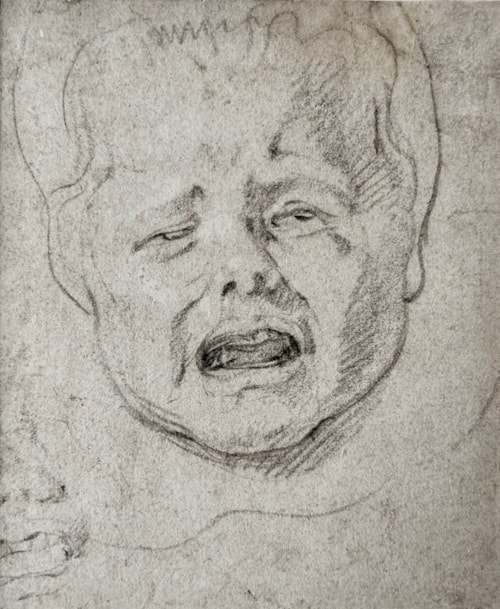Jacob Jordaens
(Antwerp 1593 - Antwerp 1678 )
Head study of a crying girl, with a separate study of her mouth
Crying children appear frequently in the work of Jacob Jordaens, notably in compositions such as The King Drinks (KMSK, Brussels). The motif clearly held the artist’s interest, and he explored it in several paintings and drawings throughout the 1630s.
The present drawing is highly characteristic of Jordaens’ style in this period (see R.A. d’Hulst, Jordaens Drawings, Arcade Brussels, vol. 1, p. 255, no. 1166). With only a few precise, energetic lines, Jordaens succeeds in conveying a striking emotional intensity. The immediacy of the expression and the confident handling of chalk reveal the hand of a master deeply attuned to the nuances of human emotion.
Jordaens frequently produced studies from life, using them as a visual reservoir for figures and facial types that would later appear in his larger compositions. Particularly intriguing in this sheet is the presence of a second, lightly sketched mouth, suggesting that the artist was experimenting with alternative expressions or refining the emotional register of the figure. This small but telling detail offers a rare glimpse into Jordaens’ working process and his search for expressive precision.
Black Chalk heightened with White, 14 x 11.5 cm (5 ¹/₂ x 4 ¹/₂ inches)
17th century
+32 (0)478 38 18 29
Hendrikus Egbertus ten Cate (1895-1955), Almelo; Sotheby’s, London, 25 February 1959, lot 23 (as Rubens).
with P. & D. Colnaghi, London.
John K. Rowlands (1931-2016), London.
Hendrikus Egbertus ten Cate (1895-1955), Almelo; Sotheby’s, London, 25 February 1959, lot 23 (as Rubens).
with P. & D. Colnaghi, London.
John K. Rowlands (1931-2016), London.



